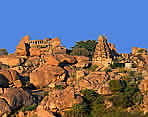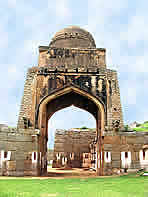| Urban Core |
| A short distance south of the Irrigated Valley are the walls of the Urban Core, the elite residential zone of the Vijayanagara capital. Parallel ridges and valleys that extend northeast southwest dominate this area. Malyavanta hill overlooks the eastern end of the zone while lower outcrops and small valleys at the west end open to plains to south and west. Massive fortifications define a large ovoid area, about 4.5 kilometres along a northeast-southwest axis. The Royal Centre occupies the south-western half of the area while the Ragunatha Temple complex on Malyavanta hill rises above the east end of the Urban Core. The remains of one of several Muslim Quarters in the city extend north-westward from the hill to the flanks of the North Ridge. The fortifications consist of earthen walls, having massive block outer revetments, with intermediate bastions, large gateways and small sally ports in strategic locations. In one area, a moat is preserved, while the rows of closely set boulders outside the wall to inhibit attacks, described in Portuguese accounts of the city, are no longer found here. Walls extend along the summits of the North and South Ridges that form the outer boundaries of the zone, cut across valleys between these and intermediate ridges and continue across the plane to the south and southwest. Segments of walls frequently are offset or change direction both accommodating themselves to changing terrain and offering angles that allow defenders to observe anyone coming near to the walls. Gateways, aligned buildings and pavements indicate major roads, while worn paths and stairways suggest some of the numerous pedestrian routes that linked the different residential areas. Major roads radiated outward from the Royal Centre following valley floors while branch roads ascended the ridges. Other roads circled around the Royal Centre. Modern roads that run through the walls of the Urban Core, some following original routes, have partly destroyed several gateways positioned in the ramparts. They include Talarighat gateway, on the road leading to the Talarighat river crossing, the barbican walls of which have recently been rebuilt. An intermediate wall contains Bhima’s gateway, so called because of a sculpture of the famous hero of the Mahabharata, while the southeast fortifications include a gateway roofed by a dome carried on four lofty arches. (See Roadways) Shrines, palace complexes, rock-cut features, tombs, and the remains of many walls occur on hillocks and the eroded slopes of ridges while most structures in the valleys are buried beneath earth washed from surrounding hillsides. Earthenware ceramics are the most common surviving artefacts of the daily life of ordinary people; their houses, which were built of mud, bamboo and thatch, have mostly disappeared. The broken pieces of Chinese blue-and-white porcelains indicate the districts inhabited by the courtly elite of the city. Almost no clearance work has taken place in this zone. However, temples dedicated to different Hindu cults, Jain temples and even two mosques indicate the diverse populations that once lived here. Water was made available in the area by a variety of features. A large tank occupied a valley in the south-eastern part of the zone. The Urban Core was supplied with innumerable wells and also with water from the Hiriya canal that snaked through the eastern end of the city. For documentation and analysis of fortifications throughout the city, see Brubaker, 2014, Vijayanagara: Warfare and the Archaeology of Defence; for description of monuments in the Urban Core, see Michell 1990, Architectural Inventory; both in Project Publications. |
|
|||||


